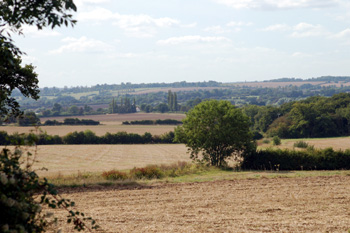Bletsoe Before 1086

Countryside looking south towards North End September 2009
Prehistory
The Historic Environment Record for Bedfordshire (which is now viewable on the Heritage Gateway website) has seven sites of cropmarks which are assumed to be prehistoric, though, without excavation it is impossible to say whether they are Neolithic, Bronze Age or Iron Age in date. Palaeolithic and Mesolithic sites can generally only be identified from finds as it is not known whether any structures may have been built at this very ancient time would still show in the landscape.
The sites are as follows:
- South of the angle formed by The Avenue and Coplowe Lane about a quarter of a mile from the village [HER 8764];
- North-west of BletsoePark Farm [HER 16578];
- South-west of Red House Farm near the boundary with Riseley [HER 16579];
- East of Bourne End Farm [HER 16580];
- South-east of Bletsoe Cottage [HER 16584];
- North-west of North End Farm [HER 16582];
- North-west of Coplar Farm near the boundary with Thurleigh [HER 16612]
Bronze Age Ring Ditches
The Heritage Environment Record identifies two sites of possible ring ditches, which are a known Bronze Age feature. They are, as the name suggests, circular ditches enclosing a compound, the function of which is still not clear. The first site [HER 8558] is north of The Roses and west of Bourne End Lane close to the parish boundary with Sharnbrook. The ditch shows as two discrete cropmarks, one a half circle the other a sub-circular enclosure of larger than average size for a ring ditch. The field in which they lie falls away gently north-west towards a small stream.
The second site [HER 16559] lies north-east of Crossways Farm, again close to the boundary with Sharnbrook. Two ring ditches can be detected as cropmarks here, roughly 200 metres apart and on top of a ridge.
Roman Occupation
The Viatores have tentatively identified a Roman road running through the parish on its way between Sharnbrook and Sandy [HER 728]. The metalled surface was found in SandyCemetery in the 1950s, and the line of the road to Sharnbrook is suggested in places by modern roads, green lanes and hedgerows, but much of it is conjectural.
When the new Rectory (now The Grange) was being built in 1936 on a site east of the A6 and north of The Avenue Roman burials were found along with pottery, coins and an ornament [HER 307]. More burials were found in 1966 and during road widening in 1967. This prompted excavations between 1967 and 1970 which discovered more burials - fifty five in all now having been recorded. Only a few had grave goods and some were partially covered, by stones.
Traces of a number of structures were also found, including a stone column fragment (now lost) indicating a substantial building, which has been interpreted as a villa which lay to the west of the Roman cemetery. One of the structures was a corn drying oven which seems to have been in the middle of the cemetery. The date of the settlement has been identified as 3rd and 4th centuries AD as the majority of the coins and the pottery found date to this period. A few 1st and 2nd century pieces have also been found.